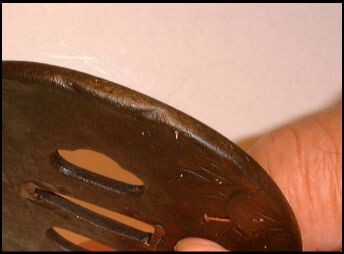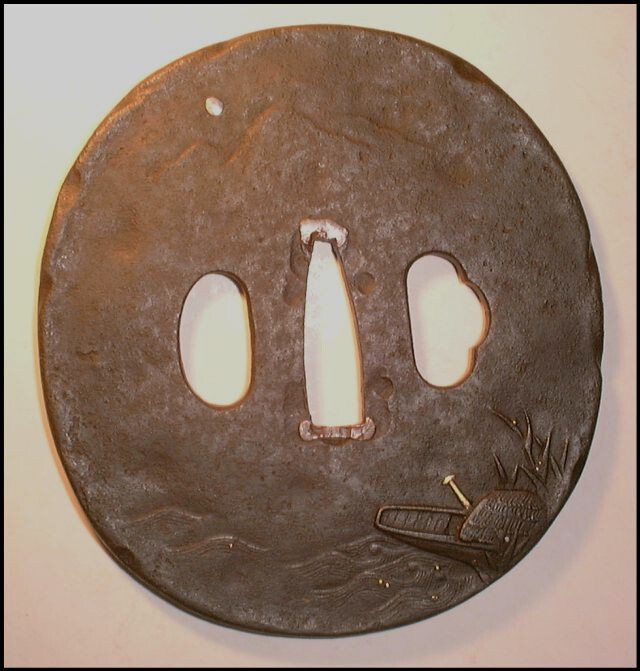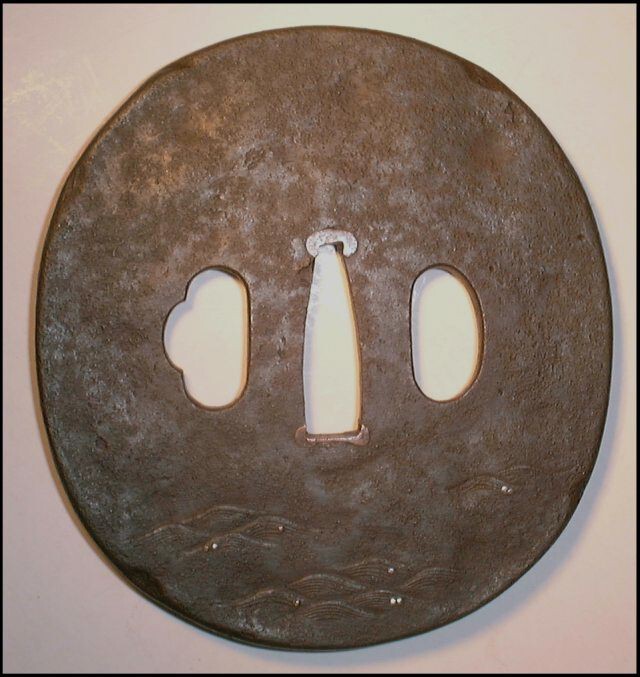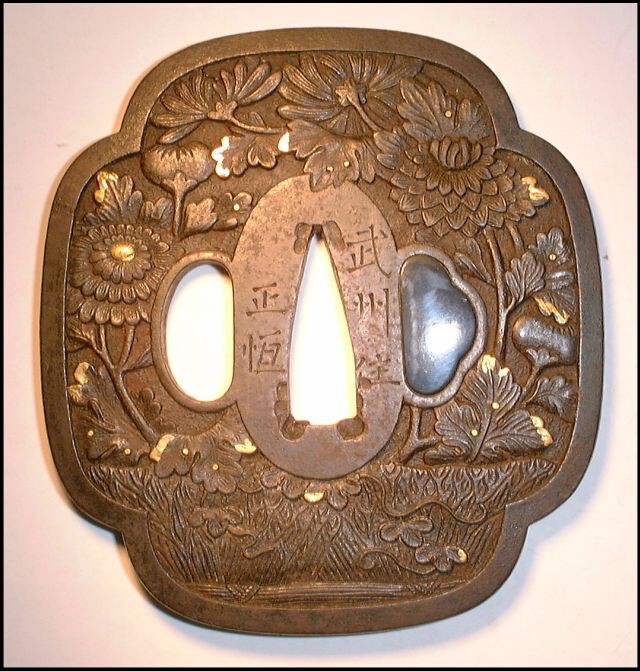-
Posts
815 -
Joined
-
Last visited
-
Days Won
1
Everything posted by docliss
-
I am currently doing some research on the tsuba of Okawa Teikan (O. Sadamasa or Sadamoto) 大川貞幹 – H 09521.0. If any members own any such work I should be most grateful for any details, provenance and images that they could provide me with for inclusion in my manuscript. With thanks, John L.
-
While I share Ludolf’s admiration of Pete’s tsuba – it is indeed very fine – I fear that I do not share his enthusiasm for the Jōi attribution. In my own – non-expert – opinion, it lacks the restraint and delicacy that I associate with the master’s work and, while the ISSAN gō and the lower seal are similar to those of Jōi, there are also marked differences in their construction. Wide variations are seen in the seals used by the master, but I am unfamiliar with the upper one on Pete’s tsuba. I await further and more knowledgeable opinions with great interest John L..
-
Thank you, Christian and Henry, for your input. In reply to Henry’s query, I am afraid that my photographs do not do justice to the tsuba’s patination, which is more like that seen in the edge-on view. But, sadly, I have to admit that it is a little dry. John L.
-
To follow a knowledgeable thread on Kaneie tsuba, can any of the members suggest a possible attribution for the attached mumei tsuba in the Kaneie style? Tsuba: An Aesthetic Study suggests that the better work of the Saga Kaneie school may be unsigned. This tsuba is of a darkly patinated iron, with a tsushime ji and a sukinokashi mimi. It measures 8.3 – 7.7 – 0.3 cm, has beautifully proportioned ryō-hitsu, and nigurome sekigane in the nakago-hitsu. On the omote surface, the stern of a punt, rendered in high relief iron and with a gold T-pole, is moored amidst bamboo. There are low relief waves with gold drops of spray and, above, a silver moon shines over the twin peaks of a mountain range. The reverse is devoid of decoration apart from a continuation of the wave theme. The overall impression is one of peaceful tranquillity. With thanks, John L.
-
Perhaps, Brian, not as 'ludicrous' as you suggest. One has seen a Namban tsuba with a single functional hitsu-ana, where the decorative undercutting included a solid rim for a second hitsu-ana, filled with a continuation of the openwork. If this second one was required, it could easily be created by the removal of its decorative filling. John L.
-
Brian, I fear that you have led me into the realm of ‘Japanese aesthetics’ – a place where I hesitate to tread – but surely a tsuba mounted with open, non-functional hitsu-ana would be completely anathema to its wearer? John L.
-
A further tsuba by Funada Ikkin I, and sadly in need of repatination, is illustrated on pp.168-9 of Robert E. Haynes, Limited: Catalogue # 7. This bears the generally accepted kao of the first master. There is also the possibility, of course, that the alternative kao on Boris’ fuchi is that of a third artist of this name, as posited by Haynes in his Index ..., rather than an alternative kao of the first master. Where does this leave us? John L.
-
Dear Ford You may have noted that in the Token Bijutsu article it states ‘We get to see not so many of the nidai’s existing works …’. This is an obvious contradiction to the generally accepted predominance of works by the second master. One does get a distinct impression of ‘work needing to be done’ in respect of these two artists. John L.
-
Boris’ fuchi is very interesting. The date of 1847 clearly places it in the period of Ikkin I (1812-1863) rather than in that of Ikkin II (1840-1885). While the kao differs from those normally associated with either of these masters, both the quality of the work and the mei suggest that this is probably a genuine work by Funada Ikkin I. Does this suggest that this artist may have used an alternative kao during his working life? Please correct me if I am mistaken, but I see no paradox in the Bonham tsuba. The kao is that generally attributed to Ikkin II: an attribution supported by the use of the gō of Yoshimori. John L.
-
Dear Ford There is an excellent article on Funada Ikkin on pp.25-29 of the English edition of the Token Bijutsu, 1991, No 48. In this it is stated that ‘the chisel cuts [of Ikkin I] are amazingly similar to his father’s, but their monograms are distinctly different ….’ These are reproduced, and show the same differences as are illustrated in Kinkō Meikan. If these illustrated kao are indeed those of the first and second master respectively, there should be no difficulty in distinguishing between the work of these two. Although I have found no suggestion that Ikkin I changed his kao during his lifetime, I do wonder if the current literature makes the distinction between the two masters too simple to be true? I regret that I am unable to obtain adequate scans of the poor photographic images of the mei in Kinkō Meikan. John L.
-
Dear Ford Kinkō Meikan lists IKKIN (First Generation) on pp.13a – 14d, and IKKIN (Second Generation) on pp.15a – 15d. It notes that the first artist used the gō of Yoshinaga, and the second those of Yoshiyasu and Yoshimori. Also that the work of the second master resembles that of the first, but that there is a ‘slight difference’ in their kao. Indeed, the kao illustrated for these two artists are quite different, and I would personally question the reliability of these attributions. What are your feelings about this? John L.
-
Although I am not normally one to recommend the submission of a fitting for shinsa, I should have thought that this tsuba would be an ideal candidate for such. John L. Sorry for the typo - for 'tsuba' read 'koshirae'. John L.
-
Dear Jan What a beautiful fuchi-gashira. As to the question as to whether it is by the first or the second generation Funada Ikkin, my initial impression, based on the character of the work and the inclusion of katakiri-bori, would be to attribute it to the second master. And by far the majority of signed work is by this artist. But the kao appears to be that of the first master, which differs to some extent from that of the second. Kind regards, John L.
-
I agree with Ludolf; I was incorrect in my previously suggested attribution. John L.
-
I agree with Grey; the mei and kao appear to be those of Omori Hidemoto. Haynes lists this artist on p.246, H 01087.0, as being the fourth son of Omori Teruhide, and working in Edo around 1790. But it would be nice to see the fuchi please, rather than simply the tenjō, in order to confirm the above attribution. And is there also a kashira? John L.
-
Dear Edward, I would summarise my thoughts of your Masatsune tsuba as follows: It is, in my opinion, a good example of C19 Bushū work, which any collector would be happy to include in his collection. The fact that it cannot be confidently attributed to a specific artist in no way detracts from its appeal. I am attaching to this message an image of a tsuba by Ito Masatsune. This is not the mei of the second master of the Ito group, H 04737.0, but of a second generation artist of this name, who died in 1775. It has been suggested that Yamagata Masatsune might possibly be the same artist as this one. With best wishes for your future acquisition of further pieces, John L.
-
There is considerable confusion over the Itō artists, and Edward is indeed correct that some authors list an artist as described by him in his posting. Kinkō Meikan, on pp.411a and b, names Yamagata Masatsune, called Tsunematsu and, later Jingorō, changing again to Jingobei upon becoming a student of Itō Masahide. But the two illustrated mei are quite unlike that on Edward’s tsuba. P.93 of Hara’s Die Meister … names an Itō (sic) Masatsune, a student of Itō Masahide and I. Masatane, and working in Yedo in the first half of the C19. But Haynes, who I tend to consider the ultimate arbiter in such matters, refers to Hara’s entry, under H 04745.0, as living in Bishū, in the province of Owari, and fails to acknowledge the existence of an Itō artist using the kanji 正常 as on Edward’s tsuba. I rest my case …. John L.
-
Dear Edzo – please append your name to your postings so that replies may be addressed correctly to you – the mei on your tsuba is, indeed, MASATSUNE, and the work is typical of that of the Bushū schools. But, and please correct me if I am in error, the kanji appear to be 正 常, using the 11-stroke kanji for ‘Tsune’, rather than the nine-stroke kanji, 恒, used by the Itō masters. Haynes lists no Bushū artist using your kanji, although H 04749.0, included with no additional information, is a possibility. Shosankenshu lists an artist using these kanji on p.50 no 255, with an elongated final, vertical stroke similar to that on your tsuba, but again gives no details of the artist. So one must conclude that your tsuba is Bushū work by a named, but unidentified artist. Kind regards, John L.
-
Dear Victor Sadly, I have to agree with Thierry that the tsuba you posted is a worthless modern copy. But some explanations as to why we have reached this opinion may be in order: • The ‘flash’ appearance of your tsuba, cast in a soft metal, with excessive gilding is typical of such work. Additionally, the nakago-hitsu is a very unconvincing, ovoid shape with no signs of the tsuba ever having been mounted on a blade. • It is signed BUSHU (NO)JU MASATSUNE, but there was no such Bushū artist. All of these, of which there were many, signed the 'Tsune' mei using the nine-stroke kanji, 恒 , rather than the 11-stroke kanji, as on your tsuba. • Bushū tsuba are typically, and with few exceptions, of iron and not of soft metal, as is your’s. Kind regards, John L.
-
Dear Ed Aware that you, through no fault of your own, rather got caught up in the flak from a previous posting, and notwithstanding that a previous thread has dealt fairly fully, with comments and illustrations, with Hirotoshi work, I am appending a few observations on the Uchikoshi school. Uchikoshi Hirotoshi was a student of Yatabe Michitoshi, and later of Tamagawa Yoshinaga II. Marcus Sesko lists seven students of this artist on p.71 of his Geneologies of JapaneseTsuba and Tōsō-kinkō Artists, including Hirochika (H 01300.0), the presumed artist of your fuchi-gashira, all of whom used the five-stroke kanji for ‘Hiro’ 弘, Haynes, on p.278 of his Index of Japanese Sword Fittings and Associated Artists, lists this artist as of the Kondō, and later of the Uchikoshi family. He was a student of U. Hirotoshi and was working ca 1825. There was an additional artist, not listed by Sesko, U. Hirotoshi (H 01416.0), who used a 14-stroke kanji for ‘Toshi’ 壽 rather than the seven-stroke kanji 寿 used by the master. His relationship to the master is unknown. I hope that this has been of some help, John L.
-
Dear Ed, I await Curran's opinion regarding the Mitsuoki tsuba, but to my eye neither the quality of the work nor the mei (supposedly a late one) are correct for the work of that master. His work is extensively forged, and I believe this to be another example of such. John L.
-
Ian, I am pleased to receive your reassuraning news re the Northern To-Ken Society but, as a paid-up Country Member who no longer receives a quarterly newsletter and can no longer access the society's web site, I hope that my disillusionment will be understood. With kind regards, John L.
-
As many of you may be aware, such a tsuba is the avatar of the Northern To-Ken Society of Great Britain. Sadly, this society appears to be in limbo at the present time. John L.
-
This entire thread is based upon the statement by Haynes, in his Study Collection of Japanese Sword Fittings, that tsuba 167 was made by ‘a tetsubin-shi, a castor of iron tea kettles’. While a great admirer of Haynes’ expertise, I see no explanation of - or support for - this statement in his book. Neither can I see any reason to suppose that Piers’ tsuba is not an example of the work of Myochin Munetoshi II (H 06292.0) as, indeed, may be Haynes’ 167. John L.
-
Dear Ford Ogawa’s redefinition, in 1987, of the Namban group of Japanese sword guards identified three discrete areas of manufacture – China, India and Japan. Tsuba of the auriculate type are frequently found to have a kebori VOC logo on the seppa-dai – an indication of their manufacture by the Dutch East India Company, most probably in India. There is no such evidence of any conventional Namban tsuba having reached Japan by this route; certainly I know of no such tsuba bearing the VOC logo apart from as a decorative motif. That is not to say, however, that none were made in India. As to your question about your sources of iron…. I would imagine that any post 1600 iron not sourced from a tatara as pure local iron, or from the Manchurian railway as pure namban iron, will have been recycled innumerable times, and will almost certainly contain a proportion of foreign iron. What proportion of such iron is considered necessary in order to acquire the label of ‘namban iron’ is anybody’s guess, I suppose. John L.






